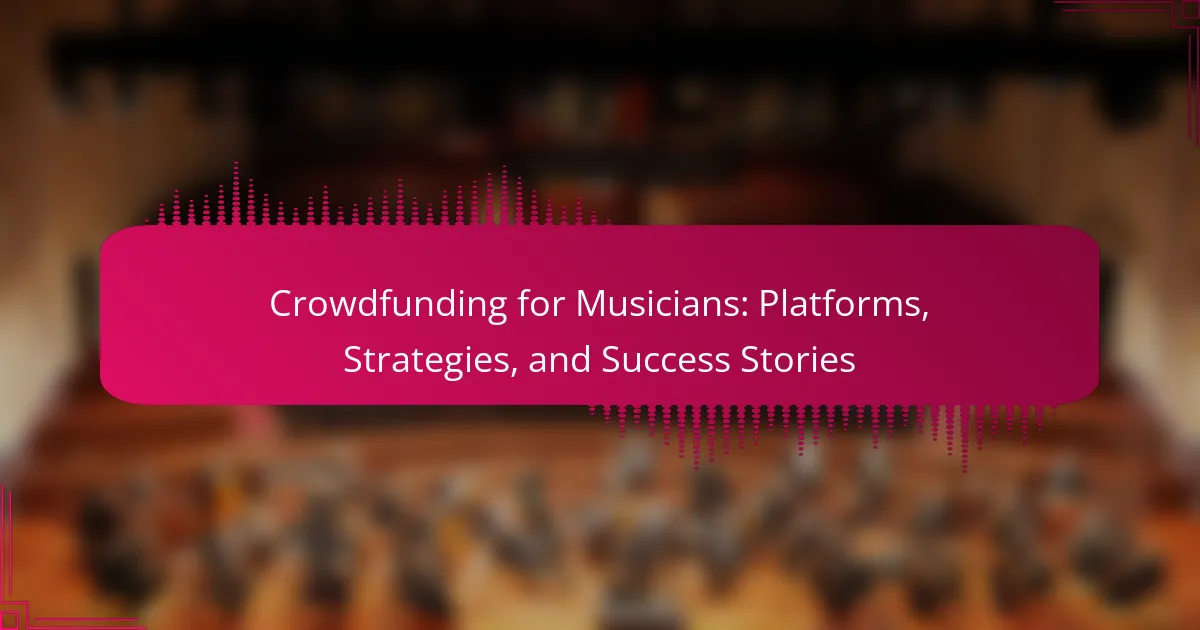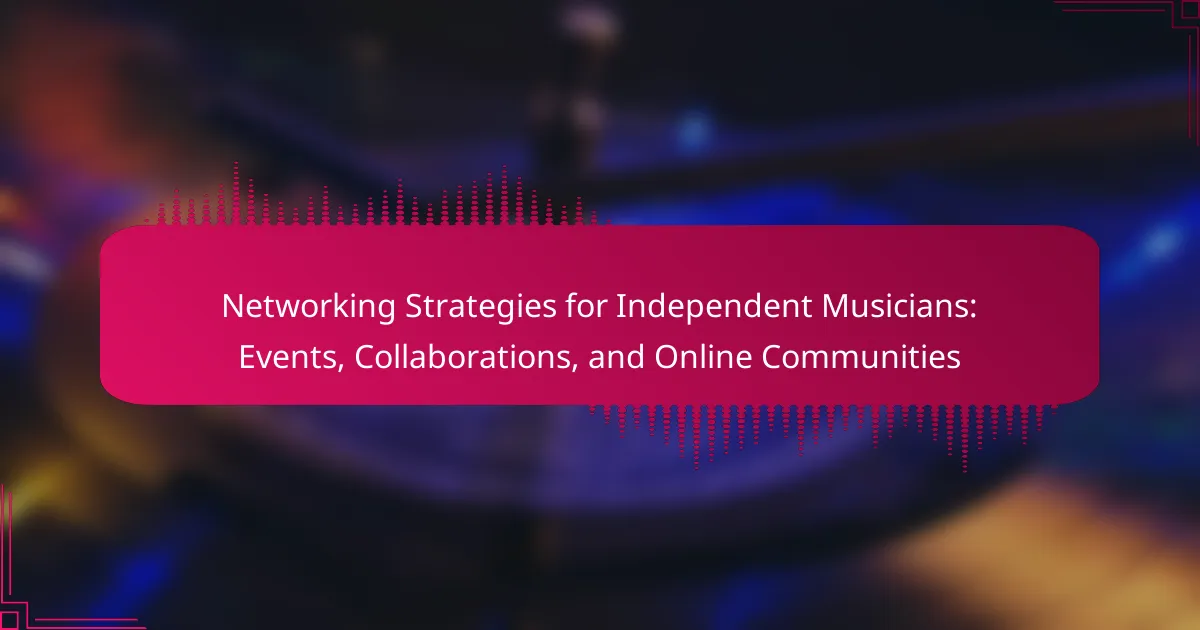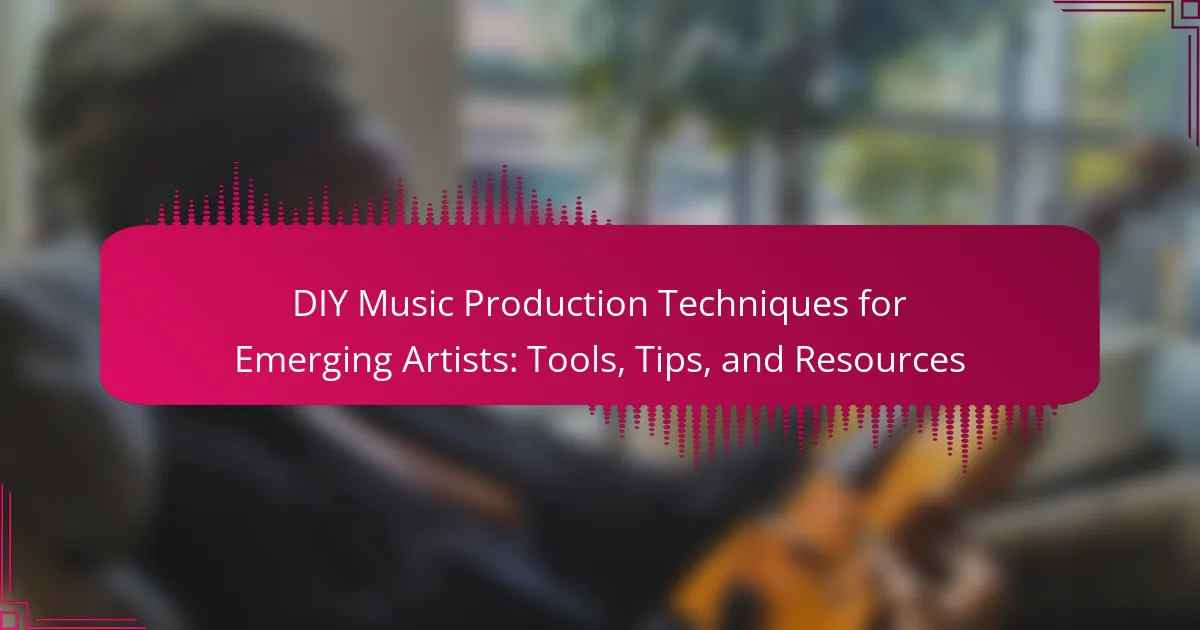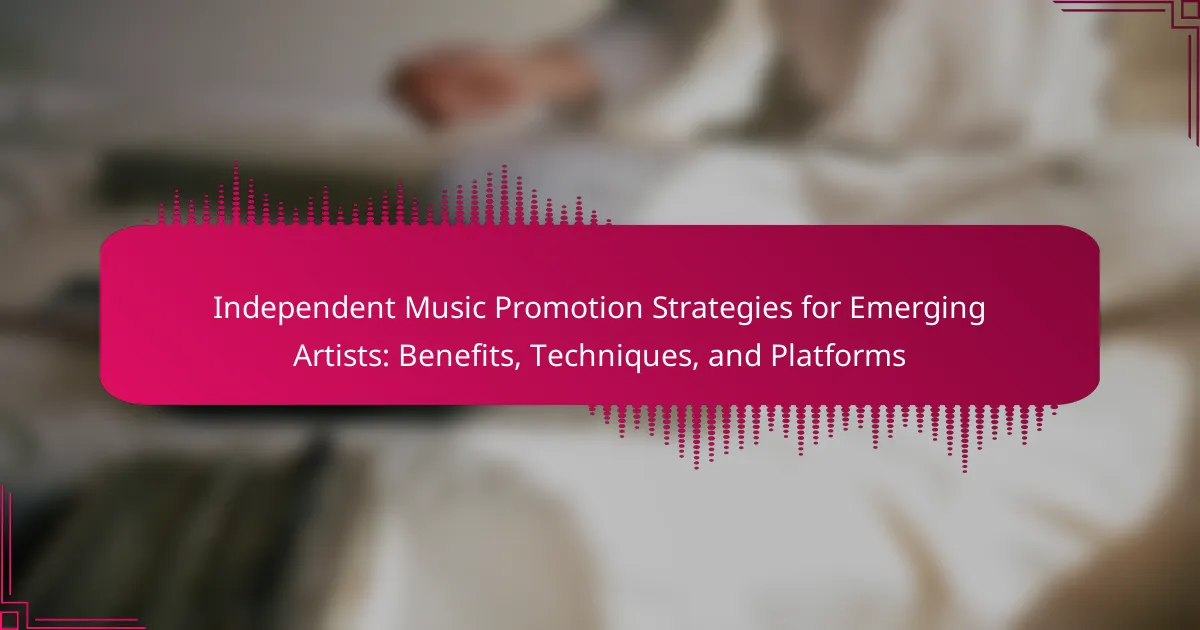Creating an effective press kit is crucial for independent artists to enhance their visibility and engage with the media. This article covers essential components like biography and high-resolution images, the importance of design for professionalism, and strategies for distribution through targeted media lists and social media. Additionally, it addresses common pitfalls to avoid, ensuring artists present a polished and compelling image to potential promoters and audiences.
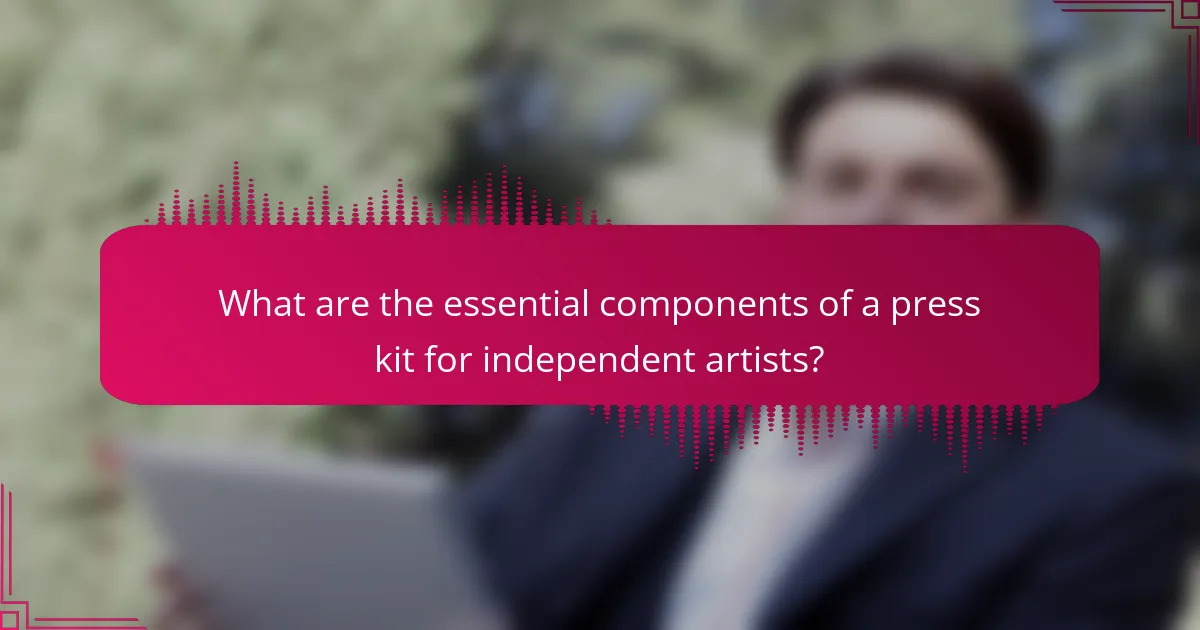
What are the essential components of a press kit for independent artists?
An effective press kit for independent artists includes a biography, high-resolution images, press releases, and contact information. These components present a professional image and facilitate media outreach.
1. Biography: A concise artist bio that highlights achievements and influences.
2. High-resolution images: Professional photos for media use, showcasing the artist’s brand.
3. Press releases: Current updates about recent projects, performances, or releases.
4. Contact information: Clear details for booking and media inquiries.
Why is a press kit important for independent artists?
A press kit is essential for independent artists as it consolidates key information and promotes their brand effectively. It enhances visibility, provides media-ready content, and facilitates connections with industry professionals. A well-designed press kit can include artist bios, high-resolution images, music samples, and press coverage, which collectively showcase the artist’s unique attributes. This comprehensive approach increases the likelihood of media coverage and booking opportunities, ultimately supporting the artist’s growth and reach in a competitive market.
Which elements should be included in a press kit?
An effective press kit for independent artists should include a biography, high-resolution images, music samples, press releases, contact information, and social media links. These elements provide essential information and promote the artist’s brand.
1. Biography: A concise overview of the artist’s background and achievements.
2. High-resolution images: Professional photos for media use.
3. Music samples: Key tracks that showcase the artist’s style.
4. Press releases: Recent news or announcements relevant to the artist.
5. Contact information: Clear details for media inquiries.
6. Social media links: Direct access to the artist’s online presence.
How can independent artists tailor their press kits to different audiences?
Independent artists can tailor their press kits to different audiences by customizing content, design, and distribution strategies. Focus on the audience’s interests and preferences to enhance engagement.
1. Identify Audience Segments: Determine specific groups such as music industry professionals, fans, or media outlets to tailor messaging.
2. Customize Content: Highlight relevant achievements, upcoming events, or unique attributes that resonate with each segment.
3. Adjust Design: Use visuals and branding that appeal to the target audience, ensuring consistency with the artist’s identity.
4. Choose Distribution Channels: Select appropriate platforms for each audience, such as social media for fans and email for industry contacts.
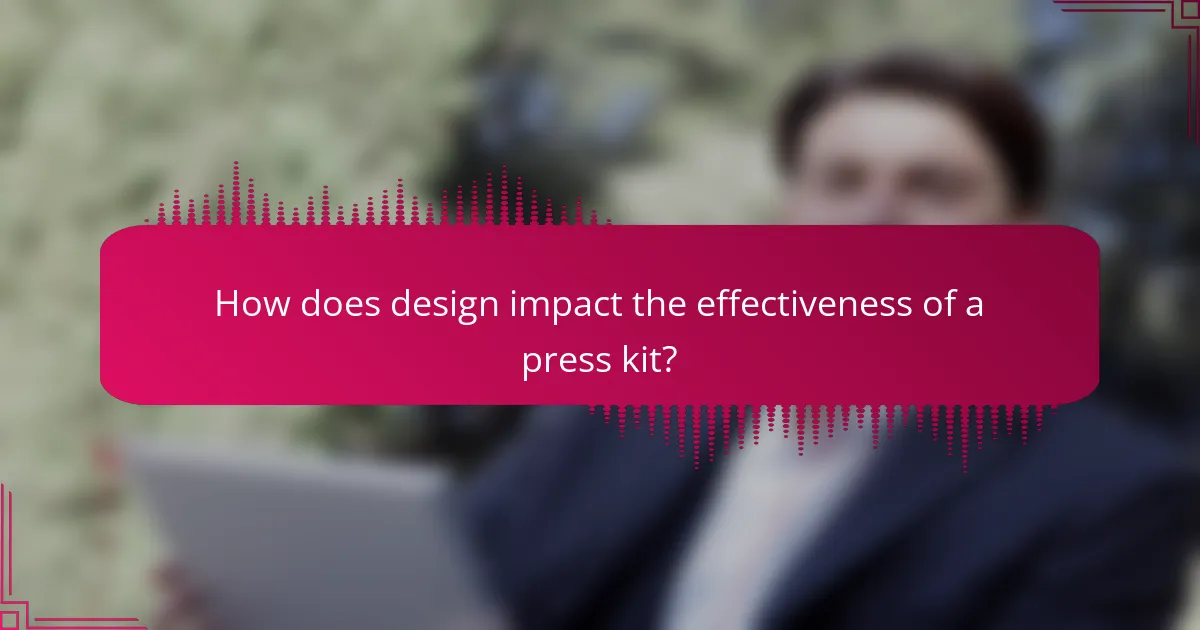
How does design impact the effectiveness of a press kit?
Design significantly enhances the effectiveness of a press kit by creating visual appeal and ensuring clarity. A well-designed press kit captures attention, communicates professionalism, and facilitates easier navigation of content. Key design elements include layout, typography, and color schemes that reflect the artist’s brand identity. Effective design also highlights essential information, making it accessible to journalists. As a result, a visually cohesive press kit increases the likelihood of media coverage and engagement.
What design principles should independent artists follow?
Independent artists should follow key design principles to create an effective press kit. Focus on clarity, consistency, and visual appeal to communicate your brand effectively. Use high-quality images and a cohesive color scheme to enhance professionalism. Ensure that the layout is easy to navigate, highlighting essential information such as biography, achievements, and contact details. Prioritize a strong first impression by incorporating unique attributes of your artistic style that differentiate you from others.
Which formats are most effective for press kit design?
Visual formats such as PDFs and digital presentations are most effective for press kit design. They allow for high-quality images, organized layouts, and easy sharing. Including multimedia elements like videos can enhance engagement. Consistency in branding across formats reinforces the artist’s identity.
How can visual branding enhance a press kit?
Visual branding significantly enhances a press kit by creating a cohesive and memorable identity. Strong visuals attract attention and convey professionalism, making it easier for media to recognize and remember the artist. Consistent branding elements, such as logos and color schemes, reinforce the artist’s message and values. This alignment increases the likelihood of media coverage and audience engagement. Additionally, visually appealing press kits can differentiate an artist in a competitive market, showcasing unique attributes effectively.
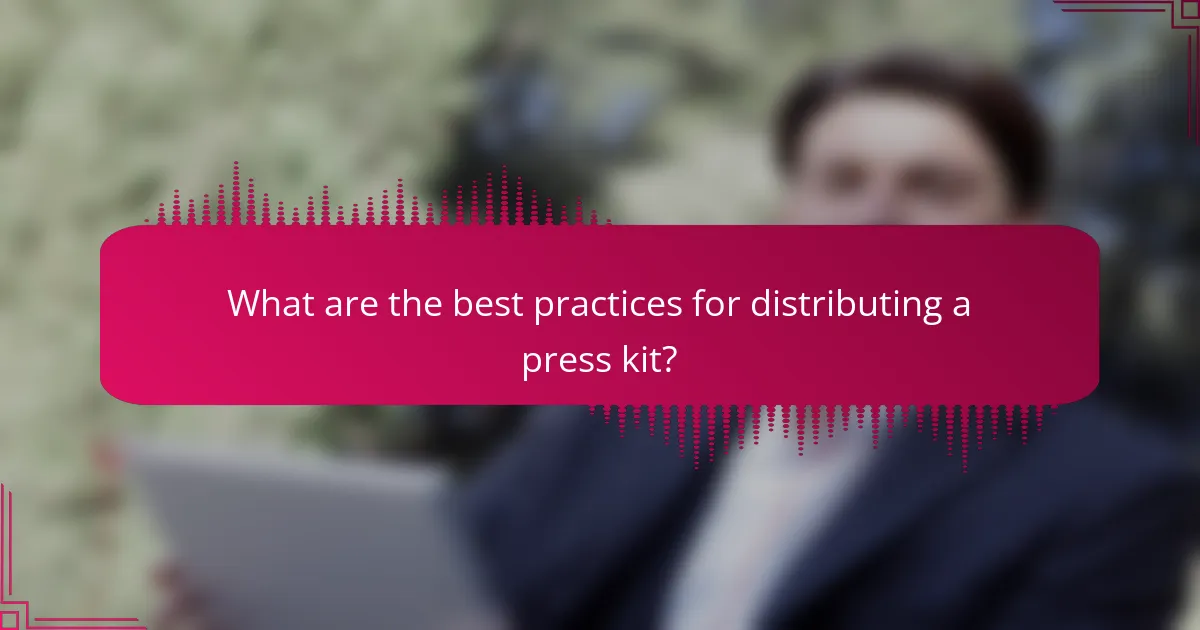
What are the best practices for distributing a press kit?
To effectively distribute a press kit, utilize targeted media lists, leverage social media platforms, and follow up with personalized emails. Focus on timing, ensuring distribution aligns with relevant events or releases.
1. Identify and curate a list of journalists and influencers in your genre.
2. Utilize social media channels to share your press kit widely.
3. Send personalized emails to key contacts, highlighting your unique attributes.
4. Monitor responses and engage with media for potential coverage.
How should independent artists identify their target media outlets?
Independent artists should research media outlets that align with their genre and audience. Identify publications, blogs, and podcasts that feature similar artists or styles. Utilize social media to engage with these outlets and analyze their content for relevance. Compile a targeted list of contacts to enhance press kit distribution.
Which platforms are best for sharing press kits?
Social media platforms, artist websites, and press release distribution services are best for sharing press kits. These platforms maximize visibility and engagement.
1. Social Media: Utilize platforms like Instagram, Facebook, and Twitter to reach a broad audience quickly.
2. Artist Websites: A dedicated section on an artist’s official website ensures easy access and detailed information.
3. Press Release Distribution Services: Services like PR Newswire and Business Wire distribute press kits to targeted media outlets, enhancing reach.
4. Email: Directly sending press kits to journalists and influencers creates personal connections and ensures the content is received.
What strategies can artists use to follow up after distribution?
Artists can effectively follow up after distribution by engaging with their audience and leveraging media connections. They should send personalized thank-you notes to journalists and influencers, share updates on their work, and encourage feedback. Regularly posting on social media about their projects keeps the audience informed and involved. Additionally, artists can organize listening parties or virtual events to create buzz around their releases. These strategies foster relationships and maintain momentum in their careers.
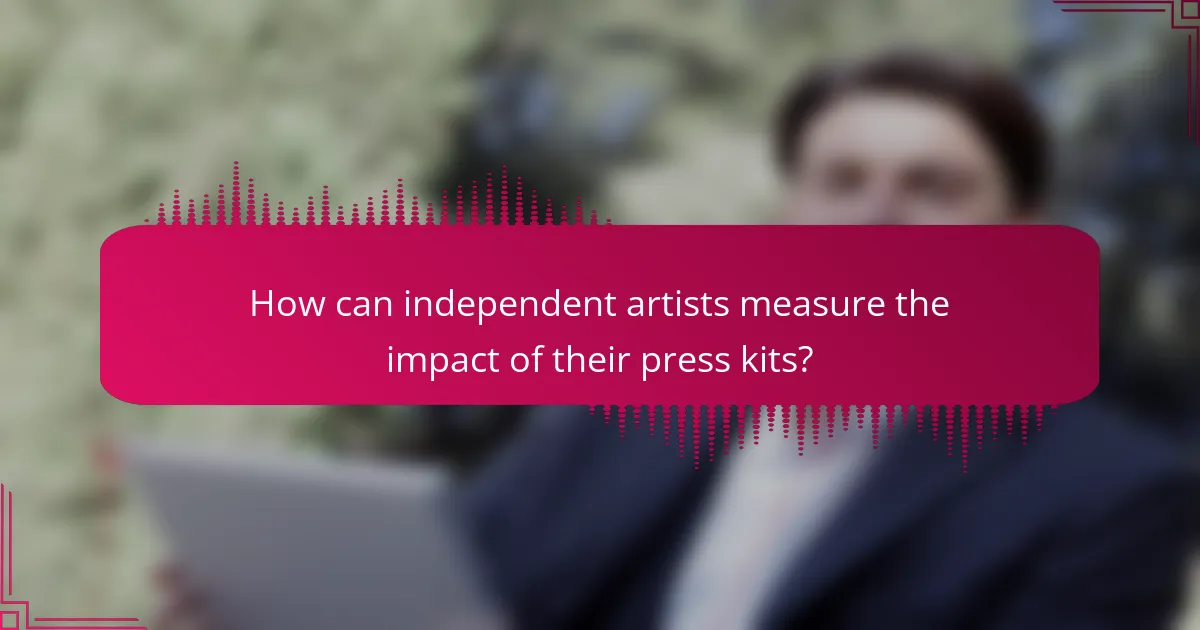
How can independent artists measure the impact of their press kits?
Independent artists can measure the impact of their press kits by analyzing engagement metrics, media coverage, and audience feedback. Tracking the number of press inquiries, social media shares, and website traffic can provide insights into effectiveness. Additionally, gathering qualitative feedback from industry professionals can highlight areas for improvement.
What metrics should be tracked for press kit performance?
Track engagement metrics, distribution reach, and media coverage for press kit performance. These metrics reveal how effectively the press kit reaches the target audience and generates interest.
Engagement metrics include social media shares, likes, and comments, indicating audience interaction. Distribution reach measures the number of outlets and platforms that disseminate the press kit. Media coverage tracks articles, mentions, and interviews generated from the press kit, showcasing its impact.
Regularly analyzing these metrics helps refine future press kit strategies and improve visibility.
How can feedback be used to improve future press kits?
Feedback can enhance future press kits by identifying areas for improvement and aligning content with audience expectations. Analyze responses to previous kits to pinpoint strengths and weaknesses. Implement changes based on constructive criticism to refine messaging, design, and distribution strategies. Regularly updating the press kit with fresh insights ensures it remains relevant and effective for independent artists.
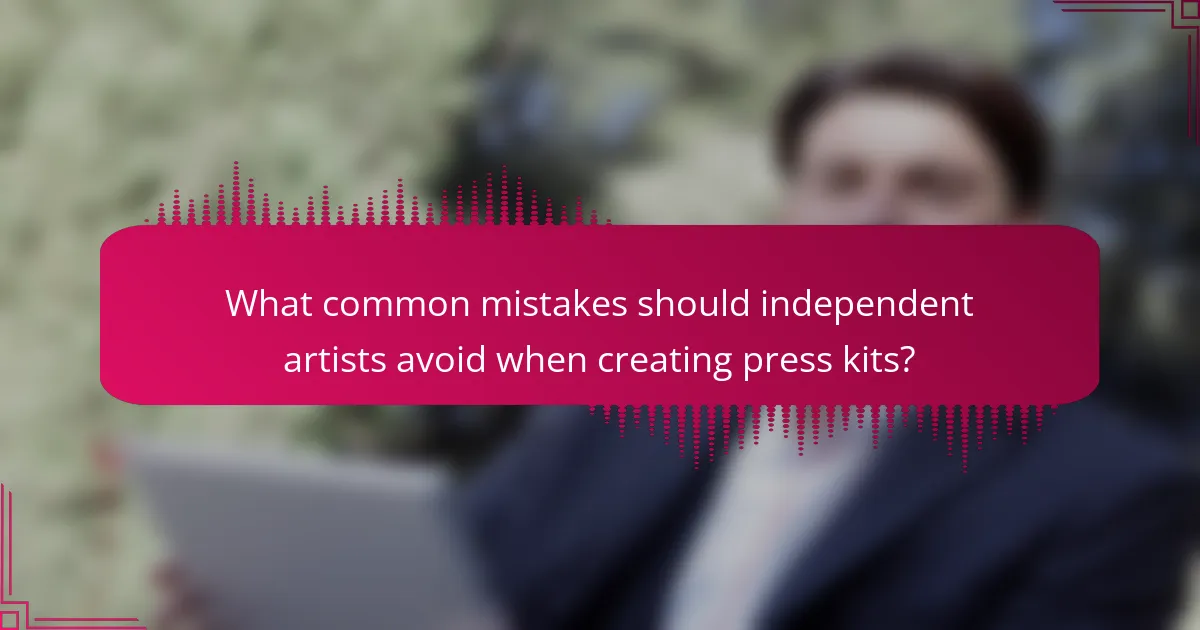
What common mistakes should independent artists avoid when creating press kits?
Independent artists should avoid common mistakes like neglecting professionalism, omitting key information, and using poor design. A well-crafted press kit is essential for effective promotion.
1. Lack of Professionalism: Ensure all materials are polished and reflect your brand identity.
2. Missing Essential Information: Include a biography, high-quality images, and contact details.
3. Poor Design: Use a clean, visually appealing layout that aligns with your artistic style.
4. Ignoring Audience: Tailor your press kit to the specific media outlets and audiences you are targeting.
5. Outdated Content: Regularly update your press kit to reflect current projects and achievements.
6. Inconsistent Branding: Maintain a cohesive look and feel across all elements of your press kit.
How can clarity and conciseness enhance a press kit’s effectiveness?
Clarity and conciseness significantly enhance a press kit’s effectiveness by ensuring that key information is easily accessible. When independent artists present their work, a clear and concise press kit captures attention and conveys professionalism. This approach helps communicate essential attributes, such as artist background and project details, without overwhelming the reader. By focusing on impactful messaging, artists can foster better media engagement and increase the likelihood of coverage.
Why is it important to keep press kits updated?
Updating press kits is crucial for maintaining relevance and accuracy. An updated press kit reflects an artist’s latest achievements, projects, and branding. This ensures that media and industry professionals have access to current information, enhancing the likelihood of coverage. Consistently revising press kits also demonstrates professionalism and commitment to one’s craft, which can attract more opportunities. Regular updates can include new music releases, upcoming events, and changes in contact information, all of which contribute to effective communication and engagement with the audience.
What are the risks of overloading a press kit with information?
Overloading a press kit with information can overwhelm recipients and dilute the core message. Key risks include loss of focus, reduced engagement, and potential miscommunication. An effective press kit should prioritize clarity and conciseness to effectively convey an artist’s unique attributes and essential information.
What expert tips can help independent artists create standout press kits?
To create standout press kits, independent artists should focus on clarity, creativity, and relevance. Start with a compelling artist bio that highlights unique attributes, such as notable achievements or influences. Include high-quality visuals, such as professional photographs and engaging graphics, to capture attention.
Organize the kit logically, with sections for music samples, upcoming shows, and contact information. Utilize a consistent design that reflects the artist’s brand identity. Finally, distribute the press kit through targeted channels, such as music blogs and industry contacts, ensuring it reaches the right audience effectively.
